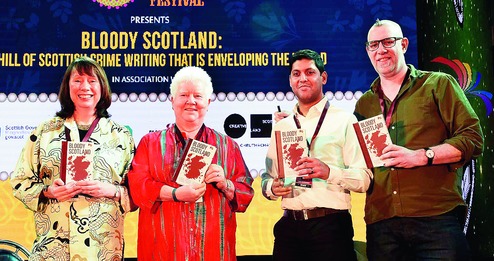If Arthur Conan Doyle had written The Hound of the Baskervilles in the twenty-first century — this adventure of Sherlock Holmes had been serialized at the turn of the twentieth — he would have been tempted to make one important modification. Jack Stapleton, with his “tin box for botanical specimens” and a “green butter-fly net”, the man who thought nothing of chasing Cyclopides across the treacherous moor, may not have been a naturalist. The catch in butter-fly nets of 21st-century naturalists has been dwindling unnoticed in the Age of the Anthropocene. A recent piece in The New York Times by Brooke Jarvis revealed that in Britain, Mr Stapleton’s home country, nearly 30-60 per cent of the population of bees, moths, butterflies and beetles has experienced a precipitous decline. In nature reserves in Germany, the families of flying insects had lost 75 per cent of their populations in just over two decades while across the Atlantic, in the United States of America, the bumblebee and the monarch butterfly have suffered losses of around 87 and 90 per cent, respectively.
Yet, in the early nineteenth century, Charles Darwin, sailing aboard the Beagle towards the Patagonian coastline, recorded in It was snowing butterflies “a few observations made at sea”. One of them, an accurate pointer to the richness of the then entomological universe, reads thus: “One evening… vast numbers of butterflies, in bands or flocks of countless myriads, extended as far as the eye could range. Even by the aid of a glass it was not possible to see a space free from butterflies. The seamen cried out ‘it was snowing butterflies’…”
Jarvis’s article also discusses the wide-ranging, but underexamined, consequences of the annihilation of insects. Birds that rely on insects are suffering: eight out of 10 partridges in the French farmlands have disappeared, as have nightingales and turtledoves. The stress on aquatic life is as acute.
Fish that require mayflies to survive are now threatened with extinction.
But today, there exists a well-oiled army of researchers, philanthropists, public relations firms, think tanks and citizens groups — Frantz Fanon calls them the “bewilderers” in The Wretched of the Earth — that is trained to challenge the idea that a mutilated environment can extract an economic price. It is plausible that at times even the bewilderers may find it difficult not to be chilled by the coldness of some facts. An investigative piece in The Epoch Times, which has a special interest in China, reported some years ago that in Maoxia, the production of the famous Maowen apples had to be supplemented by costly, labour-intensive human pollinators because of a drastic reduction in the number of bees. One of the fundamental mechanisms that has made life on earth possible — insect-borne pollination among flowers and food crops — has been gravely imperilled by this entomological armageddon and the costs, as China’s experience shows, can be debilitating for both economy and ecology.
Yet, the near-destruction of insects has remained largely unrepresented in the public discourse. One possible reason for this blind spot could be the relative obscurity of research by entomologists, many of whom are amateurs, in comparison to studies on, say, mammals in serious scientific journals. There are several explanations for this skewedness. Scientific journals, it is believed, remain indifferent to contributions from the constituency of amateur researchers. There is also evidence to suggest that species higher up the food chain occupy a disproportionate share of the attention of scientists, conservators as well as policymakers.
But that is not all; the invisibility of some kinds of ecological degradations, Rob Nixon writes in his illuminating book, Slow Violence and the Environmentalism of the Poor, is also a problem of time and scale. Culture and consciousness, Nixon argues persuasively, are excellent registers of catastrophes that are immediate and humongous. Certain kinds of disappearances, such as the deaths of lions in Gir in a short span of time, would be well-documented. But not so incremental transgressions that unfold gradually: the slow, but shocking, fragmentation of the habitats of India’s tigers must count as one such inconspicuous infringement. It is the sedate pace of these ecological crises — Nixon calls them ‘long dyings’— that renders them invisible. “Slow violence”, Nixon writes, is “… a violence that occurs gradually and out of sight, a violence… that is dispersed across time and space, an attritional violence that is typically not viewed as violence at all.” Interestingly, one of the reasons that the British journalist, Kate Dawson, cites for the absence of panic during the Great London Smog of 1952 that killed 12,000 people was the ubiquity of smogs, a familiarity that had, over the years, made Londoners indifferent to the slow but steady accumulation of toxicity in the air.
One of the primary challenges posed by these “staggered and stagger[ing]” destructions is representational. “How can we,” Nixon enquires pertinently, “turn the long emergencies of slow violence into stories dramatic enough to rouse public sentiment and warrant political intervention?” What makes it difficult to resolve this asymmetry among time, scale and representation is that humans, more often than not, fail to empathize with and hence act upon what they cannot see. Nixon also brings into contention another formidable obstacle — the effacement of particular memories. “Such displacements smooth the way for amnesia,” reminds Nixon, as sites of conflict and their eventual disintegration disappear through the cracks of public consciousness with more than a bit of help from complicit authorities.
Is there then a case to reimagine memory, individual reminiscings and those by communities, as a weapon of mobilization against such disastrous incursions? Evidence, literary and otherwise, reveals memory’s potency. Michael McCarthy’s The Moth Snowstorm is a charter for action to save what is left of nature. The solidarity that McCarthy hopes to forge with his readers is based on a shared memory of a time of abundance of creatures, great and small. The trick, McCarthy and many other writers have shown, is to use abstract forms of capital, such as collective memories that transcend cultures — the remembrance of insects clouding a solitary, luminescent bulb, for example — to wash away the thick coat of inertia that has gathered around corrective policies. McCarthy has an ally in Nixon who locates writers and the power of their stories at the heart of strategies “against attritional disasters that afflict embattled communities”.
Memory is emerging as a catalyst in not just environmental literature but also activism. In Europe, which has had a distinguished tradition of amateur naturalism, citizen scientists — researchers, collectors, volunteers, students, adolescents — are doing promising work to evaluate the extent of devastation among birds and bees in the hope that the data collected could be used by the scientific community to halt their steep slide. India, too, needs its indigenous corps of amateur naturalists, the old as well as the not-so-old, so that armed with the memory of a time past, they could fight to revive a bountiful natural world that their children will, in all probability, have no memory of.
Conan Doyle’s fictive Stapleton, Sherlock Holmes would prove in the end, was a rather malevolent creature. Ironically, the real world’s survival and redemption now depend on committed, eidetic men (and women) darting around wastelands with butter-fly nets in search of winged survivors.


